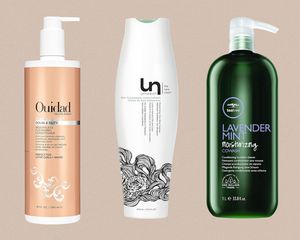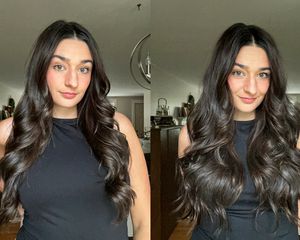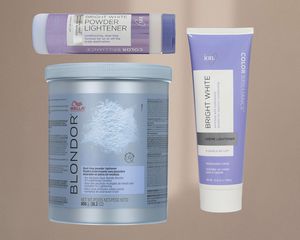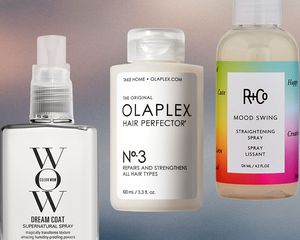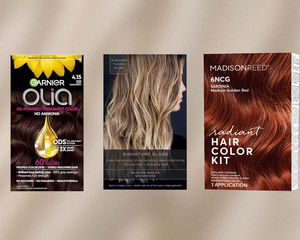:max_bytes(150000):strip_icc()/Witch-hazel-hair-5079599_800x1000_final-fe4e0cea053a45298723d8d3ab63e092.png)
Witch hazel is everywhere. While it might not be the ingredient that gets a spotlight on the packaging, it certainly shows up in a lot of products (especially when it comes to facial skincare). But did you know it can benefit our scalps, too? Particularly for certain hair types, and those with irritated scalps, this ubiquitous ingredient should definitely be in your arsenal. We spoke to a trichologist, dermatologist, and a hair transplant surgeon to learn more about how this ingredient can make a difference in your scalp care routine, how to use it, and more.
Witch Hazel for Hair
- Type of ingredient: Antioxidant-rich with antibacterial properties.
- Main benefits: Calms irritated or inflamed scalps; potentially can improve dandruff, flaking, and scalp oliness.
- Who should use it: Those with scalp sensitivity from dermatological conditions such as eczema or psoriasis, and those with oily scalps.
- How often can you use it: Our sources recommended starting out with once a week use and increasing to twice a week if needed.
- Works well with: Witch hazel should be diluted, as opposed to used alone. Mix it with rosewater, chamomile or green tea, and a carrier oil like coconut or almond, mixed and stored in a spray bottle in the fridge.
Benefits of Witch Hazel for Hair
Witch hazel is derived from the bark, twigs, and leaves of a plant called Hamamelis virginiana. “Its leaves and bark are astringent and anti-inflammatory,” says trichologist Bridgette Hill. Witch hazel is antioxidant-rich and has antibacterial properties.
As for how it works, “when applied to the scalp, witch hazel causes the pores to contract or shrink, which is excellent for managing and treating scalp conditions,” Hill explains. “There is a belief that the vasoconstrictive properties—narrowing of the blood vessels—assists with anchoring in the hair follicle and increases blood circulation directly to the follicle,” she says.
A variety of conditions can lead to scalp sensitivity—and that’s where witch hazel comes in. “Sensitivities can arise due to topical and chemical treatments, or dermatological conditions such as atopic dermatitis, psoriasis, or eczema,” says Dr. Craig Ziering, a board-certified hair transplant surgeon and restoration expert. “In these cases where the scalp is irritated or inflamed, or there is excessive cell buildup, witch hazel offers calming benefits,” he explains.
Though both Ziering and Hill are advocates of the use of witch hazel for managing irritated or oil-prone scalps, both also noted that there are not significant studies on the topic. “It has been used for years by some cultures for wound care in the dermis so it may also have natural healing factors,” Ziering notes, adding that “anecdotally, we see a whole range of potential benefits to the scalp.” Among his patients, he’s seen improvements in those with dandruff, flaking, and oily scalp.
It’s important to remember that our scalp is skin, too. In comparison to the skin on our faces, Ziering says, it’s “thicker, with more sebaceous systems and hundreds of thousands of larger follicles.” And healthy, strong hair starts below the skin’s surface. So, while witch hazel does not actually help grow hair, “the root of healthy hair always starts with a healthy scalp and proper functionality of the follicles.”
Hair Type Considerations
As mentioned, witch hazel can help manage scalp sensitivity and excessive oiliness. So for those with very dry scalps or strands, witch hazel is a definite no. “Even for those with overly oily or greasy, fine, straight hair, I would suggest only applying this ingredient to the scalp and first 1-2 inches of the hair fiber.” (Of course, if you’re using a product where witch hazel is just one ingredient, there will likely be others intended to counteract the possibility of drying your hair out.)
It’s always key to test new ingredients before fully introducing them into your routine. After all, “many plant-based products appear harmless but can result in allergic reactions,” Connecticut-based, board-certified dermatologist Dr. Mona Gohara notes.
Oftentimes natural hair types “experience oily scalp and dry hair simultaneously,” Ziering says. “However, the hair strands themselves do not tend to be oily or coated in this sebum because of the curl pattern and difference in the shape of the hair. The hair itself, as well as its kinks, coils, waves, and squiggles in the texture, don't allow for as easy transport of sebum. Therefore usually, a Black patient with natural hair can incorporate witch hazel for their scalp to clarify and manage excess oils.”
How to Use Witch Hazel for Your Hair
Whether or not you love DIY beauty, there are plenty of ways to incorporate this ingredient into your scalp and hair care routine.
- For an at-home scalp treatment: California-based, board-certified dermatologist Dr. Ava Shamban recommends diluting witch hazel rather than using it alone with something like rosewater, chamomile, or green tea, and a carrier oil like coconut or almond, mixed and stored in a spray bottle in the fridge. The resulting concoction will also have a nice cooling effect, she notes. “Using clean fingertips (never nails), massage in and around affected areas or scalp, in general, to oxygenate, circulate, lift, build-up and clarify,” she explains. “Then, brush the hair to help remove the build-up permanently. I recommend a combination of natural and synthetic bristles in small strokes from the center of the scalp away. This must be done gently for those with psoriasis or eczema.”
- To spot treat: “When scalp flare-ups occur, I suggest targeting the area with a saturated q-tip or cotton pad and gently press around the area to soothe any itching or discomfort,” Hill suggests.
- To multi-mask (especially recommended for aforementioned natural hair types with oily scalp and drier strands): Protect the hair fibers by using this opportunity to pre-treat with a pre-shampoo oil, or layer a deep conditioning mask over dry pre shampooed dirty hair. This allows the hair fibers to be nurtured simultaneously while treating the scalp, as well as adds a layer of protection to prevent the witch hazel from drying out the hair fibers should it touch more than the scalp and root of the hair fiber.
If you'd rather not DIY, you have plenty of product options to chose from. Here are some of our favorites.
A chemical exfoliant for your scalp, this serum contains glycolic and salicylic acids alongside witch hazel and rose clay to exfoliate the scalp and remove buildup.
A clarifying shampoo is a staple in the haircare arsenal of anyone who’s oil-prone or uses a lot of product. Witch hazel, tea tree oil, and rosemary leaf extract help clarify and deep clean the scalp and hair, while coconut oil and glycerin ensure it doesn't dry out.
Use this pre-shampoo soothing treatment to help banish itch. Witch hazel, apple cider vinegar, and tea tree work together to clarify, soothe, and cleanse the scalp.
The three-pronged applicator on this hybrid scalp treatment/shampoo makes it easy to ensure that the witch hazel, eucalyptus, and tea tree are actually reaching the areas of your scalp that need them most.
This clean beauty take on a foam dry shampoo uses tapioca starch and witch hazel to absorb excess oils, allowing your blowout to live to see another day.
